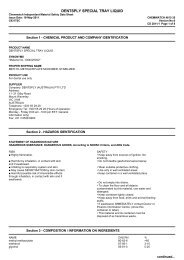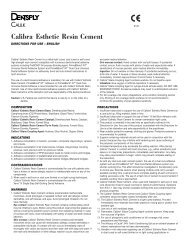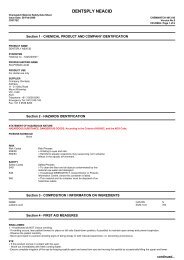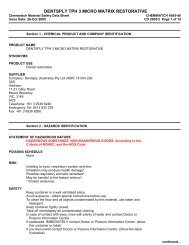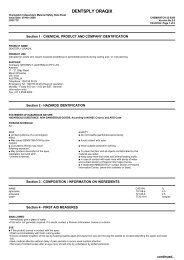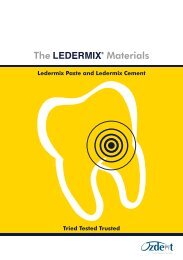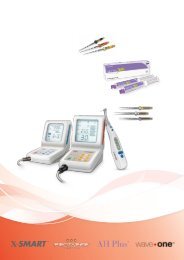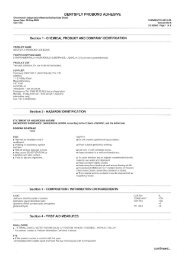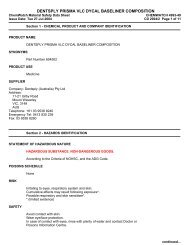DENTSPLY IRM LIQUID
DENTSPLY IRM LIQUID
DENTSPLY IRM LIQUID
You also want an ePaper? Increase the reach of your titles
YUMPU automatically turns print PDFs into web optimized ePapers that Google loves.
Chemwatch lndependent Material Safety Data Sheet<br />
lssue Date: 18-Sep-2009<br />
c931 7TC<br />
<strong>DENTSPLY</strong> <strong>IRM</strong> <strong>LIQUID</strong><br />
CHEMWATCH 8108.19<br />
Version No:4<br />
CD 200912 Page 4 of 5<br />
Section l1 - TOXICOLOGICAL INFORMATION<br />
POTENTIAL HEALTH EFFECTS<br />
ACUTE HEALTH EFFECTS<br />
CHRONIC HEALTH EFFECTS<br />
¡ Harmful if swallowed. r Limited evidence of a carcinogenic effect<br />
r lrritating to eyes, respiratory system and<br />
skin<br />
contact<br />
TOXICITY AND IRRITATION<br />
¡ Not available Referto individual constituents.<br />
r May cause SENSITISATION by inhalation and skin<br />
EUGENOL:<br />
¡ unless otherwise specifìed data extracted from RTECS - Register of Toxic Effects of Chemical Substances.<br />
TOXICITY<br />
IRRITATION<br />
Oral (rai) LD50: 1930 mg/kg<br />
Skin (human) 40 mg/24h - N4ild<br />
Skin (man): 16 mg/48h - Moderate<br />
Skin (rabbit): 100 mgl24h- SEVERE<br />
¡ Contact allerg¡es quickly manifest themselves as contact eczema, more rarely as urticaria or Quincke's oedema The pathogenesis of contact eczema<br />
involves a cell-mediated (T lymphocytes) immune reaction of the delayed type<br />
Asthma-like symptoms may continue for months or even years after exposure to the material ceases. This may be due to a non-allergenic condition known<br />
as reactive airways dysfunction syndrome (RADS) which can occur following exposure to high levels of highly ¡rritating compound<br />
Allergic react¡ons which develop in the respiratory passages as bronchial asthma or rhinoconjunctivit¡s, are mostly the result of reactions of the<br />
allergen with specific antibodies of the lgE class and belong in their reaction rates to the manifestation of the immediate type. ln addition to the<br />
allergen-specific potential for causing respiratory sensitisation, the amount of the allergen, the exposure period and the genetically determined<br />
disposition of the exposed person are likely to be decisive<br />
Particular attention ¡s drawn io so-called atopic diathesis which is characterised by an increased susceptibility to allergic rhinitis, allergic<br />
bronchial asthma and atopic eczema (neurodermatitis) which is associated with increased lgE synthesis<br />
Exogenous allergic alveolitis is induced essentially by allergen specific immune-complexes of the lgG type; cell-med¡ated reactions (T lymphocytes)<br />
maybeinvolved Suchallergyisofthedelayedtypewithonsetuptofourhoursfollowingexposure.<br />
The malerial may produce severe skin irritation after prolonged or repeated exposure, and may produce a contact dermatitis (nonallergic). Th¡s form<br />
of dermatitis is often characterised by skin redness (erythema) thickening of the epidermis<br />
The substance is classif¡ed by IARC as Group 3:<br />
NOT classifiable as to its carcinogenicity to humans<br />
Evidence of carcinogenicity may be inadequate or limited in animal testing<br />
Equivocal tumorigen by RTECS criteria<br />
ACETIC ACID GLACIAL:<br />
¡ unless otherwise specified data extracted from RTECS - Registerof Toxic Effects of Chemical Substances.<br />
TOXICITY<br />
IRRITATION<br />
Oral (human)TDLo: 1.47 mg/kg<br />
Skin (human):50m9/24hr - M¡ld<br />
Unreport (man) LDLo: 308 mg/kg<br />
Skin (rabb¡t):525m9 (open)- SEVERE<br />
Oral (rat) LD50: 3310 mg/kg<br />
Eye (rabbit): 0 05mg (open)- SEVERE<br />
lnhalation (human) TCLo: 816 ppm/3 min<br />
Inhalation (rat) LCLo: 16000 ppm/4 hr<br />
Dermal (rabbit) LD50: 1060 mg/kg<br />
r Asthma-like symptoms may continue for months or even years after exposure to the material ceases This may be due to a non-allergenic condition<br />
known as reactive airways dysfunction syndrome (RADS) which can occur following exposure to high levels of highly irritating compound<br />
The materiaì may produce severe irritation to the eye causing pronounced inflammation. Repeated or prolonged exposure to irritants may produce<br />
conjunctiv¡tis<br />
The material may produce severe skin irritation after prolonged or repeated exposure, and may produce a contact dermatitis (nonallergic) This form<br />
of dermatitis is often characterised by skin redness (erythema) thickening of the epidermis<br />
NOAELs following repeated exposure to acetic acid and its salts range |rom21O mg/kg bw/day (2-4 month acetic acid drinking water study; systemic<br />
toxicity) to 3600 mg/kg bw/day (acetic acid, sodium salt, 4 week dietary study; no effects reported). Signs of irritation/corrosion at the site of<br />
contact as well as systemic toxicity have been reported<br />
CARCINOGEN<br />
Eugenol<br />
lnternational Agency<br />
for Research on Cancer<br />
(IARC) Carcinogens<br />
Group<br />
Section l2 - ECOLOGICAL INFORMATION<br />
No data<br />
Ecotoxicity<br />
lngredient Persistence: Persistence. Bioaccumulat Mob¡lity<br />
Water/Soil A¡r ion<br />
Dentsply lRlV Liquid<br />
eugenol<br />
acetic acid glacial<br />
No data<br />
No data<br />
No data<br />
continued...




